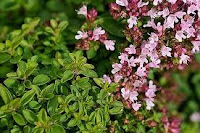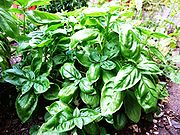For many hundreds of years people have used herbs for their healing properties. These are some of the common herbs, their uses and how to grow them. The essential oils in these plants are chemical compounds commonly extracted from the plants for use in aromatherapy. Today the oils are popular for use in soap and candle making and the dried herbs for teas and natural vitamins.
SAGE: Improves memory. It is an easy versatile herb often referred to as a cure-all for its expectorant, disinfectant and anti-fungal properties. Sage can be used orally as a tea, gargled for sore throat and to flavor food. This perennial will grow in any soil type, is drought tolerant and only requires a mostly sunny location. Sage is a good companion for most all vegetables.
THYME: Promotes good health. It was used for its expectorant and disinfectant properties to clean wounds, relieve gas and sore throats and flavor food. Tea made with the flowers is still used today as a herbal remedy. Thyme is available in many colors and flavors like lemon thyme, easy to grow in the garden or in pots.
YARROW: Increases awareness. It grows wild in regions of America, Europe and Asia. The flowers are white, yellow or red with feathery leaves and pungent fragrance. Many insects like moths, butterfly, beetles, and wasps are attracted and feed on this plants. In the middle ages this yarrow was used to heal wounds or stop nosebleeds. According to Chinese tradition it considered lucky to hang it up dried to bless a house or for ceremonies. Yarrow is an easy to grow plant that requires very little care, is drought tolerant, and is a good companion in any garden to repel pests and attract beneficial insects. Plant yarrow near any plants to protect.
CHIVES: Helps boost Immune system. Chives is high in vitamin C and iron. The flower, stems and bulbs are edible with a mild onion flavor. It can be dried, pickled or eaten fresh on food. It aids in digestion for tea or added to a meat, rice, potato or pasta dish. It's a simple plant to start from seed, grown in pots all year round indoors, is a perennial outside and will add lovely purple blooms in early summer to a vegetable or herb garden. A companion for carrots, grapes, tomato.
DILL: Sharpens the Mind. Since the beginning, mankind has cultivated this popular aromatic herb. It soothes upset stomach, expels gas, freshens breathe. Dill is commonly known now as a flavoring for pickles, fish and potato chips. This herb is easy to grow from seed is drought tolerant in gardens or pots. Let it dry and self seed on its own or collect the seeds to grow fresh dill every year. Plant as a companion with cabbage, lettuce and onion.
PARSLEY: Overall Protection. Parsley can be steeped in a cup every day as a beneficial tea to aid in digestion. It can aid with coughs and colds used as a throat gargle. Best used fresh if possible but dried also can be added to many food dishes. Parsley is simple and easy to grow fresh from seeds indoors in pots all year round. During the spring and summer you can place it outside as a good companion to lettuce, cabbage, carrot.
LAVENDER: Good for overall Health. It's known for its relaxing scented properties. As an oil it's popular in aromatherapy to treat headaches and anxiety. The essential oils in lavender are still used for bath and laundry products, candles and air fresheners. This easy to grow herb requires a simple trimming in early spring and with flower on new growth. TIP- Cut back the branches on a mature plant to about 6 or 8 inches in May. Harvest by hanging bundles up to dry in a warm, dark place. Often it will re-flower in late summer again. Use dried in sachets for linen closet, wreaths or bath balls mixed with salts.
MINTS: Improves and sharpens the conscious mind. All mints are excellent companion plants in gardens or on porches and decks. They attract many beneficial insects while repelling pests like ants and harmful beetles. These pests hate the strong smell of mint due to its high essential oil content. Some mints are invasive if planted directly in the ground; TIP- place in a large pot and sink the pot in the ground. They work well in large planters, barrels or pots so you can move them around. Growing mint only requires that they are not over-watered and get at least six hours of sun a day. Mint has been long used as an aid for heartburn, stomachache, headache and nausea. Use fresh mint to steep as tea for migraines, gas, bloating, and insomnia. There are many types, but the most common are spearmint, peppermint, lemon mint. Wild mints like Bergamot (monarda) also known as bee balm is used to flavor Earl Grey tea. Both monarda and catnip grow in open fields, ditches and meadows. Great planted around all plants in general as a companion plant.

BASIL: Promotes peace and happiness. It works as a sedative, aids digestion, relieves headaches, colic, coughs and ear infections. Rub fresh basil leaves on a bug bite to stop itching.When dried it's good in cooking for pasta, soups, pizza and much more. Used freshly chopped it's the main ingredient in pesto sauce. Basil has an intense amount of concentrated oil and the flavor will increase when heated so beware how much you use. It's an easy to grow annual: from seed start indoors any time and by June place pots out in the garden as a companion plant for beans, cabbage and tomato. The strong fragrance repels pests to protect plants from insects who feed on your crops. Grow basil fresh each year and harvest leaves before it flowers.

















